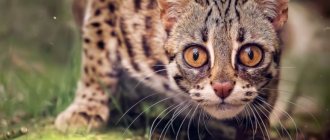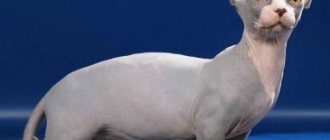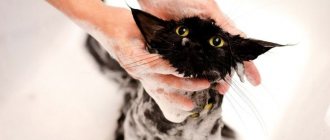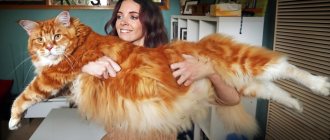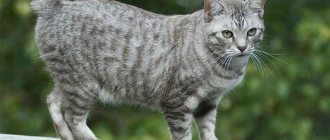Savannah is an absolutely amazing breed of cat, similar to small cheetahs. This is perhaps the most expensive breed in the world, and the reason for this is prosaic - unique external characteristics and extremely small numbers (today there are only about a thousand such cats in the world).
Yes, one thing you definitely won’t confuse with anyone else is “savannah”. Judge for yourself:
- Body type . Powerful and athletic, with a broad chest and strong shoulders. It reaches a height of 60 cm, a length of 135 cm, and a weight of up to 7 kg (in a female) or up to 15 kg (in a male).
- Head . Triangular in shape, small and graceful. The ears are large and elongated, the eyes are almond-shaped and slightly curved, their color does not depend on the color of the animal.
- Tail . For such a breed it is quite short, it doesn’t reach the floor. Slightly wide at the base, but tapers towards the tip. The color is always brighter than the rest of the coat.
- Limbs . Slender and very long, the hind limbs are longer than the front ones. The paws are oval-shaped, but not large, and the toe pads are miniature.
- Wool . Short and rough, but dense and always spotted. The savannah’s “fur coat” can be brown, golden, chocolate or silver in color.
Representatives of this breed mature late; up to three years of age they are still considered kittens. The life expectancy of savannahs, as for cats, is quite long - up to 20 years.
New breed
The first generation of Savannah cats is designated F1. The animals belonging to it are considered the most expensive, as they are half serval. All subsequent generations are formed by crossing Savannah cats with cats of similar breeds. For example, these include the Bengal, Egyptian Mau and the like. Thus, the higher the generation index, the more the animals resemble ordinary domestic cats rather than servals. Because of this, their value is greatly reduced.
As mentioned above, a Savannah cat belonging to the first generation is very expensive. And this is not surprising, since such animals are almost the rarest in the world. Although savannas were extremely highly valued from the very beginning of their appearance, their official registration took place only in 2001. As for breeding this relatively young breed, this is a rather difficult matter, so it has not yet become very widespread.
Nurseries
With the increasing popularity of the Savannah breed, the number of breeders is growing. However, it is recommended to buy a kitten from certified nurseries that are responsible for its pedigree.
32 catteries around the world are officially registered with the International Cat Association (TICA):
- 22 of which are in the USA;
- 4 – in Canada
- 6 are located in European countries: Czech Republic (SAVANNAHCZ), Germany (DANUWA), Great Britain (TOPCATSUK), Scotland (STYLISTICAT), Poland (THECATSAMONGUS), Russia (SAVANNAHGRIFFIN).
There are currently relatively few recorded Savannahs in the world, making them very special pets.
In some places, a ban on owning a Savannah cat has been introduced due to its hybrid origin. This restriction applies in Australia, as well as in some American states, including Nebraska, New Hampshire, Massachusetts, Texas, Hawaii, New York.
Savannah cats: description of the breed
These beautiful animals have inherited from their wild relatives many unique features: an elongated body, strong legs, a long neck, a short and fluffy tail with a black tip. But perhaps the most characteristic features of this breed are extremely large and erect ears, unusually beautiful eyes, and a very attractive “leopard” color.
The Savannah cat, whose photo is posted in the article, has short, thick and very soft hair. The size and location of dark spots on it are arbitrary. However, they can vary from brown tones to deep black. The color can be very diverse: silver, chocolate, golden, brown and even tabby cinnamon (light brown with dark stripes). What kind of fur a kitten will have directly depends on the appearance of a domestic cat mated with a purebred Savannah.
The size of each animal is determined by its class. The heaviest and largest Savannah cats can only belong to the first or second generations (F1 and F2), while their height reaches 50-60 cm and weight – 14-15 kg. Females are slightly lighter and smaller in size. All other generations of animals differ even more from the above norms. It must be said that savannas reach their maximum size by the age of three, and this parameter, along with weight, depends specifically on the breed of the male.
Choosing a small savannah
Of course, you should only purchase such exotic and expensive kittens from professional breeders. A kitten should be adopted at 3-4 months of age. By this time, all necessary vaccinations must be completed. A prerequisite is that all Savannah kittens undergo an aggressiveness test at 3 months of age. Only animals that have passed the “exam” for tolerance to humans are allowed to be kept at home. According to existing rules, completely “wild” individuals must be euthanized. But not all breeders follow these rules. Be sure to check your parents' documents. It’s better to see them yourself and check their pedigree.
Evaluate the kittens' living conditions and diet. Kids should be well-fed, playful, and sociable. Do not take an aggressive, hissing kitten: this will never grow into a good-natured hunter, which an adult savannah should be.
When choosing a kitten, be careful, pay attention to its parents and conditions of detention
Savannah kittens are quite expensive. Where there is big money, there is a high probability of deception. Having a pedigree is not a guarantee that they will sell you a purebred kitten. In order not to fall for the bait of scammers, you need to know the external characteristics of the breed, although in small Savannahs they are not yet sufficiently pronounced. Therefore, pay attention to the pattern and color of the coat. The only color allowed for this breed is spotted. Only in black savannahs can the spots be weakly expressed. Unacceptable: marbled color, tricolor spots in the form of rosettes, white spots. Parallel stripes run from the head to the shoulder blades and fan out towards the tail on the back.
Savannah cats: description of general breed standards
- Large animals with a somewhat elongated slender body.
- A small wedge-shaped head set on a long neck.
- The ears are wide at the base, large and pointed at the tips.
- Long, strong and slender limbs.
- Almond-shaped eyes are copper, yellow or green, or any of their shades.
- Short, soft and rather thick fur of the so-called “leopard” color.
- The spots are black or brown, the rest of the fur is chocolate, silver, brown, golden or tabby cinnamon color (photo of a savannah cat).
Adults and their character
The behavior of these animals is completely different from the wild nature of their relatives - the servals. Savannahs quickly become attached to a person, seeing him as their companion, and in this they are very similar to dogs. In addition, they can demonstrate the same loyalty to their owner as dogs. However, despite their attachment to a person, they easily tolerate loneliness. Savannah cats are very inquisitive and brave animals. They prefer active games, but if the owner has no time to tinker with them, then they will occupy themselves - for example, they will play a little prank, putting their own order around the house.
Their most favorite pastime is games that simulate hunting. For cats, the most important thing is the process of chasing prey, so that they can run and jump to their heart's content. Most likely, they inherited such preferences from their wild ancestors - the servals. Sometimes, some Savannah cats can be quite aggressive, but this is very rare. It happens that during play, animals can somehow injure or scratch a person, so they are not recommended to be left alone with small children.
Horoscope compatibility
Some people who decide to buy a Savannah are interested not only in photos of the breed and reviews about it, but also whether it has qualities suitable for their own character. Zooastrologers believe that the savannah is most suitable for the energetic, purposeful Aries, friendly, intellectually developed Gemini, shy, affectionate Virgo and confident, freedom-loving Sagittarius. But with proper socialization, the Savannah can become a loving, loyal friend for each of the zodiac signs.
Savannah is a unique cat, combining the features of an agile African predator and an affectionate pet, devoted to its owner. Majestic beauty, intelligence, and good character make her the most desirable pet among the cat family.
Caring for an animal
Despite the fact that the Savannah cat breed is exotic, it does not require any special care. Since these animals are short-haired, all attention to their fur comes down to combing and bathing. The first of the procedures is done once a week, and the second - no more than 4 times a year. Savannah cats love to walk in the fresh air and for this it is best to use a leash.
For purebred animals, experts always recommend using exclusively balanced nutrition, which is easily provided with the help of special premium-class feed. They vary slightly depending on the age of the cat. At the same time, breeders strongly recommend avoiding feed with a high grain content. In addition, from time to time it is advisable to add special cat treats to the food, which contain taurine, as well as agents that help remove hair from the stomach.
As for natural products, it is necessary to add small pieces of raw meat to the food, since it is believed that this particular product extends the life of savannahs by about 5-10 years. They should not be given fermented milk products that are recommended for cats of other breeds, because this can lead to stomach upset. The feeding regimen and portion size must be checked either with the breeder, or read the instructions on the food package. Most often, kittens are fed at least 3-6 times a day, and adults - no more than 3 times a day.
Genetics
When studying the genetics of a savannah, special terminology is used to determine how many generations it is removed from its serval ancestor.
Each generation is marked with the letter F with a serial number:
- F1 = 1st generation from an African Serval parent (has 50% Serval blood);
- F2 = 2nd generation with Serval grandparent (25% Serval);
- F3 = 3rd generation with Serval great-great-grandparents (12.5% Serval).
The following generations are designated using a similar principle, ending with F7. Then if the female is crossed again with a Serval, the Savannah kitten will have 75% of the father's blood and will inherit his appearance. Females are fertile from the 1st generation, male descendants are infertile until the 5th generation (F5), they are kept as pets. Individuals allowed to breed are very selective, mating only with those with whom they are raised from infancy.
Content Features
Before such a Savannah cat appears in the house (the photo shows its external features), it is necessary for all family members to get together and discuss the rules for handling the animal in order to develop a unified principle for its upbringing. If there are many rooms in the house, then you should first keep the kitten in one or two, and over time introduce him to the rest of the rooms. In this case, it would be advisable to place several trays at once in different parts of the house.
If Savannah cats are kept in an apartment above the second floor, then all mosquito nets should be strengthened as much as possible. The fact is that both the base and their fastenings are made of plastic, so if animals show excessive interest in birds, insects, etc. flying outside the window, then they can fall out and, having landed on it, receive various types of injuries .
We should not forget about poisonous indoor plants. They will need to be kept as far away from the overly curious kitten as possible. In addition, for at least seven months, you will have to secure or hide the wires of electrical appliances, since during this time Savannahs can use them as teethers. Do not underestimate the usual safety measures: be sure to close containers with water, packs of washing powder and other household chemicals, and remove valuable and breakable items.
Optional equipment
Savannah cats love to jump and climb, so you need to take care of at least special multi-level shelves on the walls. In private homes, a safe and spacious enclosure can be equipped for them. It can accommodate not only shelves, but also a whole tree. It is worth noting that permanently keeping an animal in an enclosure is simply unacceptable. Such cats need daily one- or two-hour walks. It must be remembered that their free range is highly undesirable.
Usually, a scratching post is also placed near the feeding area. It is not so important what configuration it will be, but most often it is a tall pillar with a small platform at the top. It would be a good idea to ask which scratching post the kitten is already used to. As a rule, the Savannah cat (photo) is very smart, so it is quite easy to retrain him: you just need to use a spray containing valerian or catnip.
How to care for a hybrid cat
Savannah is a very large cat and requires a lot of space and equipment for active play. Such a pet is not suitable for keeping in an apartment. He will be more at ease in a private house, where it is possible to keep a cat indoors during the cold season, and in a spacious enclosure in the summer.
The dense, short savanna coat with a thick undercoat does not mat and does not require daily combing; it is enough to walk through the coat with a stiff brush once a week to remove dead hairs. It is necessary to keep the large ears clean and, when dirty, clean them with a soft cloth. Regular brushing of teeth is a must. The cat needs to be accustomed to it from childhood.
Unlike its counterparts, the savannah loves water, so there will be no problems with swimming. It is not recommended to wash your cat too often, but it is worth regularly organizing water parties for it; you can equip a special pool for the animal on the site.
Savannahs love water, you can even build a pool for it on your property
It is necessary to take into account the dimensions of the savanna when installing a toilet. Most likely, you will have to make a large tray with your own hands and take into account that a savannah needs much more litter than an ordinary cat. You will also need to negotiate with your semi-wild pet about spreading the litter yourself. The best thing to do is to train your Savannah to use the toilet. To do this, you need to make a special cover with a small hole on it.
Feeding the savannah
There are two opinions regarding the nutrition of the savannah. Some suggest feeding your hybrid cat premium dry food, while others suggest sticking to a natural diet. There is no doubt that the Savannah, as a direct descendant of the wild cat, needs a lot of meat. This should be taken into account when choosing a natural diet.
Savannah will need to be fed meat
The diet should include:
- various cereal porridges with boiled meat;
- raw meat;
- offal (liver, lungs, heart);
- turkey;
- chickens;
- fish (infrequently, but regularly).
When feeding naturally, be sure to use vitamin and mineral supplements.
Proper nutrition is balanced, which will ensure good health for the cat and prolong its life.
Animal breeding
As mentioned above, the Savannah cat, the mating of which is associated with certain characteristics, was obtained by mating a serval and an ordinary domestic pet. As is known, representatives of this breed belonging to the early generations have a certain level of so-called hybrid non-viability. It manifests itself in the sterility of male serval hybrids up to the fifth generation. They are given to new owners already neutered.
Most often, Savannah cats are bred with F5 males, i.e. the fifth generation. In addition, mating of females of this breed with ordinary short-haired mongrel cats is allowed, as well as with Egyptian Mau, Ocicat, Bengal and Oriental shorthair, which have a spotted color.
Features of development
It is known that the gestation period for ordinary domestic cats is about 65 days, and for the Serval - up to 77. As a result of this difference, hybrids of earlier generations are often born prematurely, and therefore urgently need additional nursing. The litter of hybrids of the first two generations usually consists of 1-2, and the subsequent ones - of 3-5 kittens. Savannah cats can become pregnant as early as 4 weeks after giving birth, however, breeders themselves limit the number of matings to two or three per year.
These animals feed their kittens with milk for up to 8-12 weeks. At first, babies will almost always sleep. In this state, their body is aimed at maximizing the production of growth hormone. This is why it is not recommended to wake or disturb kittens in any way during this period. Once they reach the age of 10-12 weeks, they are spayed or neutered in order to be soon transferred to new owners.
Medical problems
Having decided to get such a cat, you must take into account that walking in an enclosure or on a leash requires additional both financial and time costs: accustoming to the street, maintaining the enclosure, preventive examination by a veterinarian, deworming, additional vaccinations, etc. A trip to the veterinary clinic with The savannah of the first two generations often turns out to be a problematic undertaking both for the animal itself and for its owner.
No special health problems have been identified in representatives of this breed, with the exception of those that are inherent in other domestic cats. Usually, all difficulties that arise can be resolved by regular veterinary examinations, timely vaccinations, high-quality balanced nutrition and good care.
Health
Savannah is unique here too - it is the only artificially bred breed that is completely devoid of genetic diseases. There are two reasons for this: the natural immunity and health of the serval and, since this is a hybrid breed, the lack of interkinship.
To maintain good physical shape, the Savannah needs to move a lot and be active.
Kittens need to have all their vaccinations and deworming done on time. With good care and physical activity, Savannahs can live up to 17–20 years.
Author's experience: Savannah living in Siberia
Savannah is a heat-loving creature. It is believed that the descendant of the African cat will not be able to live in a cold climate. The story of one Savannah named Zosya proves that each animal of this breed is unique and does not want to fit into the generally accepted framework.
It all started with the fact that one of my wealthy acquaintances, having read specialized literature, wanted to have a savannah at home. He lives in Siberia, his cottage is located far outside the city, almost in the taiga. All the warnings that an expensive cat would not survive in our conditions and 18 thousand dollars could be wasted had no effect. The kitten was ordered from one of the American nurseries. How a 4-month-old baby survived a multi-hour flight is a mystery. I met the owner with the kitten at the airport. Judging by the mood and condition of the small animal, the only thing that bothered him was hunger.
Having entered the household and looking around a little, Zosya went straight to... the doghouse. We read, of course, that savannahs quickly find a common language with dogs, but not so much! It is not known what language the Siberian wolfhound and the little savannah spoke, but it took them less than half an hour to become bosom friends. Growing up, Zosya felt more and more like the mistress of the house. She did not allow herself any special liberties, but she treated all members of the household, except the owner, with undisguised contempt. Having occupied the owner's pool, she loves to take water procedures alone and gets very angry if she is disturbed.
When the first snow began to fall, Zosya’s joy knew no bounds. The African woman fell in love with playing snowballs. Of course, she cannot, like a lynx, live in the cold in the snowy taiga. But in any weather she demands that she be allowed to visit the wolfhound Rudolf, who lives in the yard, every day.
For the first year, Savannah Zosya was under constant supervision of a personal veterinarian. According to him, the heat-loving cat has adapted perfectly to the Siberian climate.
Owner reviews
Happy owners of Savannahs are sure that this is perhaps the most intelligent and inquisitive cat of all the breeds existing today. They easily open not only the doors of the rooms, but also the cabinets themselves, while pulling out all the drawers. They are not at all afraid of water and take baths with pleasure. These animals are very good at jumping to a height of more than 2.5 meters.
Savannah cats (photo), especially those belonging to the first generations of hybrids, can sometimes show their wild temperament, which is expressed by growling and hissing in the presence of strangers. In addition, he can make special chirping sounds characteristic of servals. Such a pet will not sit in the arms of even its owner and does not like to be stroked on the head. But the fourth generation Savannah is practically no different in behavior from other domestic cats.
Advantages and disadvantages
Savannah cats are exotic animals that require special treatment. Therefore, before getting a pet, you need to weigh the main pros and cons.
Pros:
- Looks like a graceful wild cat, but is suitable for living in a domestic environment.
- Affectionate, sociable with people and animals.
- Very smart and trainable.
- Loves to swim.
Minuses:
- In some places, ownership of Savannah cats is prohibited.
- The breed is rare and expensive.
- Prone to hypertrophic cardiomyopathy.
- A special diet may be required.
